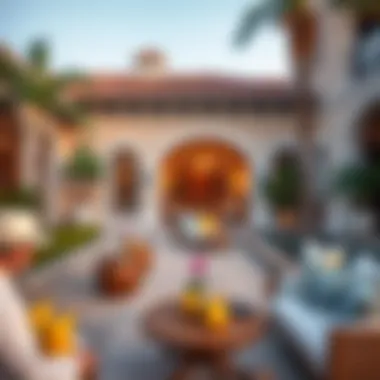Exploring Venice, Dubai, and Southern Influences in Real Estate


Intro
The real estate domains you see in Venice and Dubai represent two ends of a diverse architectural and cultural spectrum. Venice, with its meandering canals and historic structures, juxtaposes sharply against Dubai’s dazzling skyscrapers and luxury developments. Add into the mix the rich southern influences, and what unfolds is not just a real estate market but a tapestry woven from distinct threads of culture, history, and lifestyle. Investors and homeowners alike are increasingly drawn to explore these intersections. This article aims to unpack the layers that constitute the real estate in these regions, examining how tradition mingles with innovation.
Property Trends in Dubai
Dubai stands as a testament to modern architecture and design. Its real estate market is consistently evolving, making it a hotbed for investors looking to capitalize on the latest trends.
Emerging Neighborhoods and Hotspots
In recent years, certain neighborhoods are gaining traction as promising investment zones. Areas such as Dubai Marina and Business Bay have transitioned from being merely attractive locales to essential hubs for both expatriates and locals. As urban populations swell, places like Dubai South and the newly envisioned Dubai Creek Harbour are emerging with fresh opportunities.
- Dubai Marina: Known for its waterfront lifestyle, this neighborhood is a blend of high-end apartments, retail spaces, and leisure amenities. It's perfect for those who seek the energetic buzz of urban living.
- Dubai South: Focused on creating a sustainable environment, this area packs a lot of potential for the future with its massive aviation and logistics hub.
Market Analysis and Future Predictions
The demand for luxurious yet affordable housing options is on the rise. Investors are keenly observing how shifts in global economics affect real estate prices in Dubai. While the market has fluctuated, the overall trend shows promising growth. Analysts indicate that properties in well-planned communities with amenities aimed at lifestyle choices are likely to yield higher returns.
"Dubai’s real estate market is a beacon for those who seek rewarding investment avenues. Its blend of culture, modernity, and lifestyle options create a unique appeal that is hard to ignore."
Investment Opportunities
With an eye on both short-term gains and long-term holds, real estate investment in Dubai is appealing. The ongoing developments, paired with increasing access to financing, make it an attractive proposition.
High-ROI Property Types
Certain types of properties are consistently reported to provide high returns on investment. These include:
- Luxury Apartments: High-end units in prime locations such as the Palm Jumeirah often see a good market.
- Commercial Properties: Office spaces that cater to a growing workforce in tech and finance sectors offer solid returns.
- Villas: As families settle in, five-bedroom villas in gated communities remain consistently sought after, thus ensuring rental and resale potential.
Financing and Mortgage Options
The landscape of financing real estate in Dubai is broadening. With various lenders presenting competitive rates, potential homeowners and investors have ample choices:
- Fixed-Rate Mortgages: Attractive for long-term plans, these provide stability in payment patterns.
- Variable Rate Mortgages: For those willing to take on a bit of risk, these could yield lower initial payments based on market conditions.
In essence, understanding these dynamics and planning accordingly can offer significant advantages for investors.
For deeper insights into Dubai's market trends, consider visiting resources like Dubai Land Department,
Intro to Venice and Dubai
Venice and Dubai stand as two poles in the realm of real estate, each with a distinct identity yet sharing intriguing connections. The importance of understanding these two cities cannot be overstated, especially in the context of real estate, which transcends mere structures and touches on culture, history, and economic trends.
As we explore these cities, we unravel their unique characteristics and investment potential, allowing property enthusiasts and investors alike to grasp the myriad opportunities available. The juxtaposition of Venice, with its waterways and historical richness, against Dubai’s towering skyline and modernity, creates a fascinating narrative that resonates with investors.
In this article, we'll delve into specific elements that showcase the value of both markets, anchoring on the allure of architecture, cultural nuances, and market trends. We’ll examine how these influences interact and shape real estate decisions, providing keen insights for homeowners, developers, and agents who wish to navigate these diverse landscapes successfully.
Historical Context of Venice
Venice's roots stretch back over 1,500 years, making it a veritable treasure trove of architectural styles and history. Founded as a refuge from barbarian invasions, its canals became a network for trade, allowing the city to flourish economically. The Gothic architecture that emerged here is not just visually striking; it represents an era when Venice was a formidable trading power, forging connections with far-off lands. Unique structures like the Palazzo Ducale and the Basilica di San Marco reflect the city’s history of wealth, political power, and cultural exchange.
This historical legacy means that real estate in Venice is imbued with significance. Properties are not merely units of space—they’re pieces of living history, appealing to investors who appreciate heritage. Understanding this context is crucial for anyone looking to invest in Venetian real estate, as it influences both valuation and desirability among potential buyers.
Dubai's Emergence as a Global City
In stark contrast, Dubai's transformation from a modest fishing village to a global powerhouse has been meteoric, less than a half-century old. With a vision focused on diversification and modernization, the emirate has redefined urban living. Its skyline now boasts architectural marvels like the Burj Khalifa, which epitomizes innovation and luxury. The strategic initiatives of Dubai’s rulers have attracted global talent and investment, cementing the city’s status as a business hub.


The rapid development in Dubai's real estate market continues to offer lucrative opportunities. The influx of expatriates and international businesses perpetuates a cycle of demand for both residential and commercial properties. Recognizing these dynamics is vital, especially for those considering investments in Dubai, as it reflects the ebb and flow of market trends driven by demographic shifts and economic changes.
Architectural Significance
Exploring the architectural significance in the realms of Venice and Dubai reveals how buildings are not merely structures but narratives etched in stone, glass, and steel. These cities embody the craftsmanship of their respective eras, reflecting historical context, adaptability, and cultural vibrancy. The architectural landscape in Venice, with its unique Gothic styles, stands in stark contrast to the sleek, modern lines that dominate Dubai's skyline. This juxtaposition creates a fascinating dialogue about what defines space, beauty, and functionality in real estate.
Ultimately, a keen understanding of architectural significance can influence both investment decisions and lifestyle choices among prospective buyers and investors. For instance, properties that capture the essence of local styles—whether rooted in Venice's historical past or Dubai's rapid modernism—can convey a sense of belonging and identity, which is especially appealing to discerning homeowners and investors alike.
Venetian Gothic Influence
The Venetian Gothic architecture is not just confined to books and classrooms; it’s alive in the winding canals and narrow alleys of Venice. Characterized by pointed arches, intricate decorative schemes, and an extensive use of natural light, this style paints a vivid picture of a bygone era that still resonates today. San Marco Basilica, with its opulent mosaics and ornate facades, stands as a testament to this architectural movement.
The influence of Venetian Gothic extends beyond aesthetics. It offers insights into Venice's socio-economic conditions and cultural exchanges during the late medieval period. Today, as real estate enthusiasts look into properties, an understanding of such architectural markers can enhance their appreciation for the value of these homes. Investing in structures that embrace this historical style can yield long-term benefits, both in terms of value and the unique charm they bring to the residential environment.
Modern Developments in Dubai
When we shift our gaze to Dubai, the architecture tells a different story. The city has become a beacon of modernity, showcasing how advancements in technology can reshape our understanding of space. Iconic buildings like the Burj Khalifa and Dubai Mall are not just tourist attractions; they are symbols of ambition, innovation, and economic dynamism.
The modern developments in Dubai often borrow elements from international styles, resulting in a melting pot of architectural designs that cater to diverse tastes and preferences. These contemporary structures emphasize sustainability, luxury, and technology, presenting a unique opportunity for investors. Properties with eco-friendly designs or smart home technologies are increasingly sought after, as they resonate with a forward-thinking populace that values both aesthetics and functionality. From soaring skyscrapers to sprawling villas in gated communities, understanding modern developments aids potential buyers in identifying where their investments will thrive in the ever-evolving landscape of Dubai.
Southern Architectural Styles Impact
Southern influences in architecture reveal fascinating layers in real estate beyond the conventional Western and Eastern paradigms. For instance, the brick-and-mortar charm seen in certain stunning villas in Dubai mirrors the Southern plantation homes characterized by broad verandas and expansive gardens. Salvaged timber and wrought iron decor can be spotted in both regions, blending local customs with a sense of southern elegance.
Furthermore, the infusion of Southern design principles can soften the stark modernization often associated with urban landscapes. In development projects, the aesthetics of Southern architecture can bring a warm, approachable feel to public spaces and residential homes alike. For investors, properties that successfully integrate these styles may not only appeal to local buyers but can also attract international interest, leading to broader market opportunities.
Understanding these intersections of architectural influences allows real estate stakeholders to make more informed choices, potentially enhancing their investment strategies whether they're looking to buy a home or develop commercial spaces.
"Architecture is a visual art, and the buildings speak for themselves." – Julia Morgan
By remaining attuned to the unique architectural currents that flow through Venice, Dubai, and the Southern styles, investors can harness these insights, marinating their decisions in both historical richness and modern appeal.
Real Estate Trends in Venice
The Venetian real estate market showcases an intricate tapestry woven from historical wealth, cultural allure, and the resilient spirit of its inhabitants. Understanding real estate trends in Venice is crucial for investors, homeowners, and developers looking to navigate this unique landscape. The convergence of timeless architectural beauty with contemporary housing demands provides valuable insights into market dynamics, pricing strategies, and investment opportunities. This section will delve into these aspects, demonstrating why a firm grasp of Venice’s real estate trends is key to successful property ventures.
Market Dynamics and Pricing
Venice's real estate market is as layered as its canals, offering a mixture of opportunities and challenges. Recent shifts have revealed a fascinating interplay between traditional property values and modern demands. Home prices have seen fluctuations, often dictated by seasonal tourism and local economic factors.
In areas like San Marco and Cannaregio, demand for properties is consistently high. The historical charm of these neighborhoods keeps buyers and renters eager, which pushes prices upward. Conversely, more remote areas are experiencing slower appreciation rates.
Key factors impacting market dynamics include:
- Tourism Influence: Seasonal fluctuations lead to rental price variances, particularly in short-term and vacation rentals.
- Limited Supply: With Venice's unique geography, new builds are scarce, leading to a high demand for historical properties.
- Cultural Heritage Status: Properties situated near significant landmarks often command premium prices due to their desirability and status.
Amid all this, investors must keep a finger on the pulse of local regulations, especially concerning tourist rentals that can uphold or hinder business profitability.
Buying Trends Among Foreign Investors
Venice's allure cannot be overstated. It beckons investors from across the globe, each lured by the city’s blend of culture and history. Recent trends indicate a growing appetite among foreign buyers, particularly from the United States and China.
These investors are often drawn to:
- Heritage Properties: Many seek authentic Venetian homes or apartments, favoring historical buildings that possess character.
- Cultural Experiences: The unique local culture and traditions appeal to those who seek more than just a property— they want a lifestyle.
- Investment in Renovations: There’s a steady interest in buying properties to restore and modernize, capitalizing on both investment returns and personal satisfaction.
However, foreign buyers should tread cautiously. Market knowledge is vital to avoid pitfalls associated with local laws and property management challenges. The complexity often requires collaboration with local agents who know the ropes, making informed decisions essential.


Historical Significance of Properties
The historical context of any property in Venice cannot be underestimated. Each building tells a story that intertwines with the city's past, offering its owner a piece of living history. Properties in Venice often have unique architectural features influenced by centuries of trade, culture, and artistry.
Some key elements to remember:
- Preservation Laws: Many properties are subject to strict regulations designed to maintain their historical integrity. Understanding these laws is important for any buyer.
- Cultural Heritage: Owning a piece of history enhances the property’s appeal and value; such properties often appreciate at a different rate compared to newer developments.
- Investment in Heritage: Buyers willing to invest in the restoration of historical properties can find themselves benefiting from an increase in value over time.
In essence, the real estate trends in Venice are not just about numbers; they reflect a vibrant narrative that binds the city to its global significance. For those keen on investment, understanding these trends is an indispensable step toward navigating the Venetian market effectively.
Dubai’s Real Estate Landscape
Dubai’s real estate market stands as a beacon of luxury and innovation amidst the vast deserts of the UAE. As one of the world’s fastest-growing cities, it continues to attract a diverse range of investors and homebuyers who are drawn to its opulence and modernity. With stirring architectural achievements and an ever-evolving skyline, Dubai presents a unique landscape where both aesthetic allure and profitability converge. This section delves into the intricacies of Dubai's real estate phenomenon, focusing on key components that distinguish the market.
Luxury Sector Growth
The luxury real estate segment in Dubai is more than just a sector; it reflects the city’s image as a global hub for extravagance. Properties like the Burj Khalifa and Palm Jumeirah have set a high bar, captivating affluent buyers from around the globe. This growth is underpinned by several factors:
- High Demand: Demand for high-end properties is skyrocketing, driven by wealthy expatriates and investors seeking a second home in a tax-friendly environment.
- Global Events: Major events, such as the World Expo or luxury conferences, amplify interest in premium real estate, which leads to price hikes in sought-after areas.
- Amenities and Lifestyle: Buyers are increasingly looking for more than just a home; the lifestyle attached to luxury properties, including exclusivity and high-end facilities, plays a critical role in their decision-making.
The surge in luxury developments like the Dubai Creek Tower or the recently introduced Vida Residences Dubai Marina are prime examples of how the market adapts to meet rising expectations. Investing in this segment not only carries the promise of high returns but also positions investors in an elite circle, appealing to status as much as financial incentive.
Affordable Housing Developments
Contrary to the glittering luxury sector, Dubai has placed significant emphasis on affordable housing initiatives. With a growing population, the need for accessible homes has grown more pressing. Important aspects include:
- Government Initiatives: The Dubai Land Department has rolled out various projects aimed at making housing options more accessible for middle-income families. This includes the allocation of land for affordable projects and easing regulations for developers.
- Sustainable Communities: The new affordable housing developments focus on sustainability, promoting eco-friendly construction methods that align with global standards.
- Market Demand: Boxed in by soaring prices in luxury segments, more residents are looking for budget-friendly options without sacrificing quality. This trend opens up opportunities for investors looking to tap into the less saturated, yet equally essential, market.
City planners and developers are recognizing the potential for profit in affordable housing, marking a shift in the narrative from purely high-end properties to a more inclusive approach to development.
Commercial Real Estate Opportunities
The commercial real estate scene in Dubai is vibrant and brimming with potential. Various sectors play a role in this dynamic market:
- Business Hubs: Areas like Dubai Silicon Oasis and Dubai Media City are transforming into formidable business ecosystems that attract local and international firms, creating a need for modern office spaces.
- Retail Developments: The rise of e-commerce has prompted innovative retail strategies. Dubai is evolving into a shopping paradise, evident through developments like the Mall of the Emirates and The Dubai Mall, making the retail space lucrative for investors.
- Logistics and Warehousing: With Dubai’s strategic location as a gateway between the East and West, logistics properties are seeing remarkable demand. Investors are exploring warehousing opportunities, particularly in areas close to transport nodes and ports.
In summary, whether it is through navigating the qualitative luxuries of high-end developments, investing in accessible housing solutions, or seizing opportunities in commercial spaces, Dubai's real estate landscape remains versatile and adaptable. This vibrancy not only supports the local economy but also opens gateways for international investors looking to enter a market that promises diversity amid its challenges.
"Dubai is often likened to a phoenix that rose from the sands, an entity that transcends mere geography to symbolize aspiration, luxury, and modern living."
Potential investors should closely monitor these trends as they consider positioning themselves within Dubai's dynamic real estate framework. More insights can be found on sites like Encyclopaedia Britannica, Reddit, and relevant government resources available from GOV UAE to stay informed about shifting trends.
Cultural and Lifestyle Influences
The world of real estate isn't just about bricks and mortar; it's deeply intertwined with the cultures and lifestyles of the regions in which properties are found. The influences of Venice, Dubai, and regional southern factors create a rich tapestry that shapes not only the look and feel of architectural developments but also the way people live and interact with their environments. Understanding these cultural dimensions can provide both investors and homeowners with key insights into the local market.
Venice’s Unique Local Culture
Venice, often dubbed the "City of Canals," possesses a distinct cultural identity that stems from centuries of history. Its unique blend of art, tradition, and modernity greatly influences local real estate trends. When one strolls through its winding alleyways or stands in the enchanting piazzas, there is an almost palpable sense of heritage that seeps into everyday life.
Key aspects of Venice’s culture include:
- The prevalence of art and architecture, exemplified by works from Titian to contemporary installations.
- The significance of festivals like Carnevale, which attracts visitors and adds economic vitality to real estate.
- The preservation and restoration of historical buildings that make up the intricate cityscape.
This deep-rooted culture enhances property value, making homes not just living quarters but a piece of an artistic legacy. Buyers often look for homes that are not only functional but also resonate with the local culture, blending art and lifestyle seamlessly.
Dubai’s Diverse Community


Dubai prides itself on being a melting pot where cultures converge. With a massive expatriate population, the essence of different cultures creates a unique lifestyle that attracts international investors. From bustling souks to luxurious shopping malls, the community's diversity enriches the real estate scene immensely.
Factors contributing to this ambience include:
- An array of dining options that reflect global cuisines, making gastronomic experiences part of everyday life.
- Community events that foster a sense of belonging among diverse groups.
- Fascinating local markets blending traditional and modern elements, showcasing the blend of old and new.
Real estate in Dubai is shaped by this vibrant community lifestyle. Investors note the importance of catering to this diversity, creating spaces that resonate well with both locals and expatriates.
Southern Influences in Lifestyle Choices
Southern influences, characterized by hospitality, warmth, and an easy-going lifestyle, play a pivotal role in shaping real estate in both Venice and Dubai. These southern attributes transcend borders, creating a welcoming atmosphere for residents and visitors alike. Living spaces that evoke comfort and community lead to higher demand in the real estate market.
Notable southern characteristics to consider include:
- An emphasis on outdoor living spaces, inspired by temperate climates, which urges the integration of patios and gardens in property designs.
- The celebration of community through neighborhood gatherings and shared spaces, influencing property layouts.
- A strong connection to family and heritage, often prioritizing multi-generational homes within the buying trends.
Recognizing these influences allows investors to tailor their offerings to meet market demands while contributing to a sense of place that enhances community living.
Understanding the cultural and lifestyle influences can enhance both investment opportunities and the living experience, making it a vital aspect of the property market in nuanced locales like Venice and Dubai.
Investment Opportunities
When it comes to real estate, discernment in recognizing investment opportunities is pivotal for maximizing returns. In today's global market, regions such as Venice and Dubai are not merely attractive for their aesthetics or luxury; they harbor potential avenues for investors looking to diversify their portfolios. Understanding the nuances of these opportunities requires a nuanced analysis of both regional characteristics and broader market dynamics.
Risk and Returns in Venice
Venice's unique character as a city built on canals offers a distinctive backdrop for real estate investment. However, this comes with an array of risks that investors must navigate carefully.
- Flooding Risks: The city is prone to flooding, particularly during high tides. Properties with good flood defenses will often fetch higher prices.
- Market Restrictions: Zoning laws in Venice can be intricate. Certain areas have historical protections, which can both limit development and enhance property value.
- Annual Returns: Rental yields can vary substantially, often yielding between 3-6%, depending on location, size, and the type of property—vantage points that savvy investors should prioritize in their decision-making process.
While the risks may seem daunting, the historical significance and charm of properties have consistently drawn attention from foreign investors and enthusiasts alike, making it a melting pot of high-end investment potential.
Exploring High-Yield Options in Dubai
Dubai stands as a beacon for real estate investment, especially when it comes to high-yield options. The economic stability and ambitious initiatives undertaken by the government boost investor confidence. Some key aspects to consider include:
- Luxury Sector Growth: With developments such as Bluewaters Island and the Burj Khalifa surroundings, high-end properties attract significant rental inflows, often delivering yields of 7% or more for investors.
- Diverse Property Types: From lavish villas in Dubai Hills to comfortable apartments in Jumeirah Lakes Towers, each property type appeals to different segments of renters.
- Tax Incentives: Dubai offers unique benefits with zero property tax, making it an attractive spot for those looking to maximize net returns.
Investors can delve deeper into specific projects that show promise, pinpointing developments that align with the shifting demographic trends.
Understanding Market Entry Strategies
Entering the real estate market in Venice or Dubai necessitates a well-thought-out strategy. Each region demands an understanding of its cultural and economic landscapes to facilitate smart investment decisions.
- Local Partnerships: Forming alliances with local real estate agents or developers can provide insider knowledge, enabling fresh entrants to navigate the intricate legal landscape.
- Focus on Emerging Areas: In both Venice and Dubai, up-and-coming neighborhoods often offer better buying conditions than established hotspots. Identifying these areas early can yield substantial benefits.
- Adaptation to Trends: Keeping an ear to the ground regarding lifestyle changes—like the increasing demand for environmentally friendly buildings—will empower investors to make informed decisions aligned with current market preferences.
Ultimately, successfully navigating the real estate terrain in Venice and Dubai hinges on informed strategies and an understanding of evolving trends.
In sum, Investment Opportunities in these dynamic regions are characterized by potential rewards as long as one factors in the associated risks and tailors entry strategies accordingly. Investors willing to delve into thorough research and cultivate local relationships may find themselves well-positioned to seize lucrative prospects.
Culmination
Understanding the intricacies of real estate in Venice and Dubai, framed by Southern cultural influences, opens doors to a myriad of considerations for investors and stakeholders. This article highlights how the architectural variances and vibrant lifestyles in these locales not only enhance their individual appeal but also create unique investment opportunities. The cross-pollination of ideas, from Venice's historical depth to Dubai's cutting-edge modernity, illustrates the potential for significant returns and cultural enrichment.
In summarizing the key insights, it's critical to acknowledge the fluidity of these markets. Investors need to be attuned to the dynamics at play—historical preservation versus contemporary demands in Venice, and the ever-expanding luxury market in Dubai. Each property's narrative, steeped in local customs and global influences, affects pricing strategies and buyer motivations.
Furthermore, the impacts of Southern cultural motifs cannot be understated. They provide texture and flavor to the real estate offerings, bridging connections between communities and enhancing livability. These elements, combined with a thorough exploration of market trends, form the backbone of a compelling investment strategy that transcends mere transaction.
"Investing is not just about numbers; it's about understanding the stories that properties tell."
Looking ahead, being aware of future trends becomes crucial. Not only should investors keep an eye on economic shifts and demographic changes, but they must also monitor emerging areas where Southern influences become integral to urban development. The increasing integration of sustainable practices and smart technology will shape how these regions evolve, forcing traditional and modern architectures to coexist. As the global market is in constant flux, adaptable strategies will set successful investors apart.
A prudent approach to investments in Venice and Dubai, infused with insights into cultural synergies, will pave the way for fruitful endeavors in the vibrant tapestry of global real estate.















